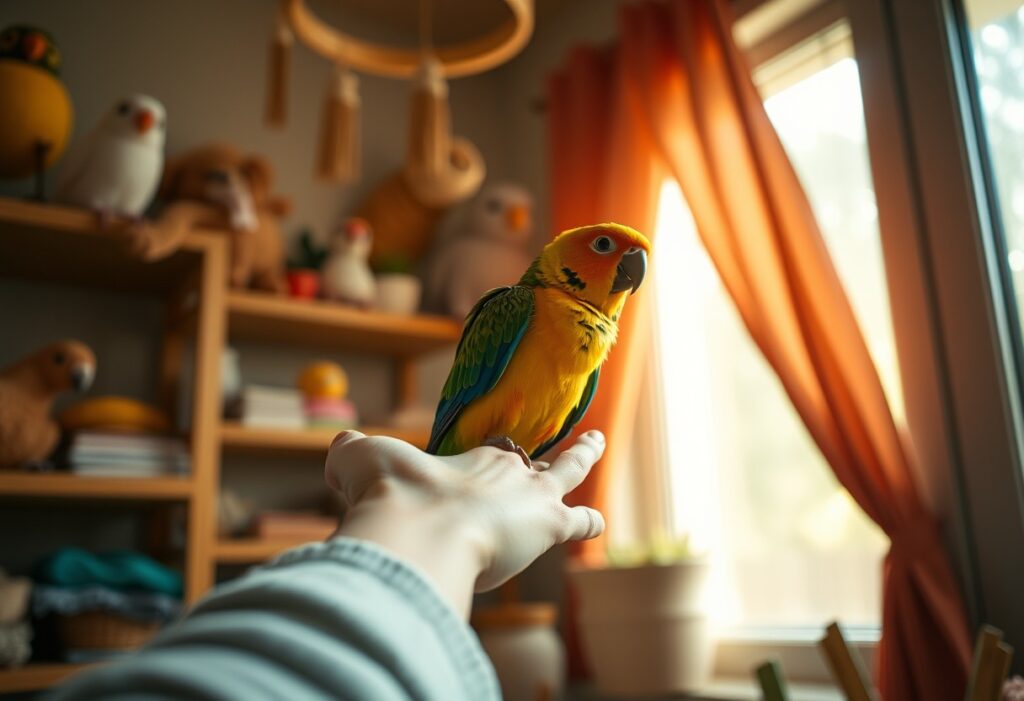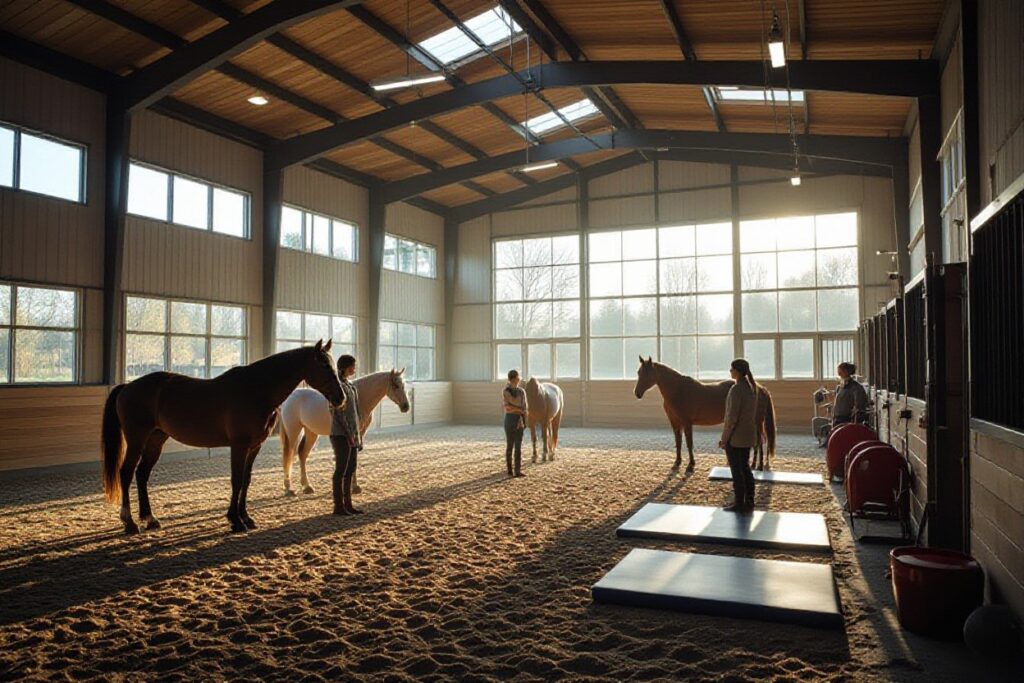There’s a profound connection waiting to be nurtured between you and your pet bird, encompassing both trust and affection. Establishing this bond is necessary for your bird’s emotional well-being and can lead to positive behaviors and enhanced interactions. By understanding your bird’s unique needs and social behaviors, you can create a safe space that fosters confidence and loyalty. This guide will provide actionable steps to build a strong relationship, ensuring mutual respect and love flourish in your home.
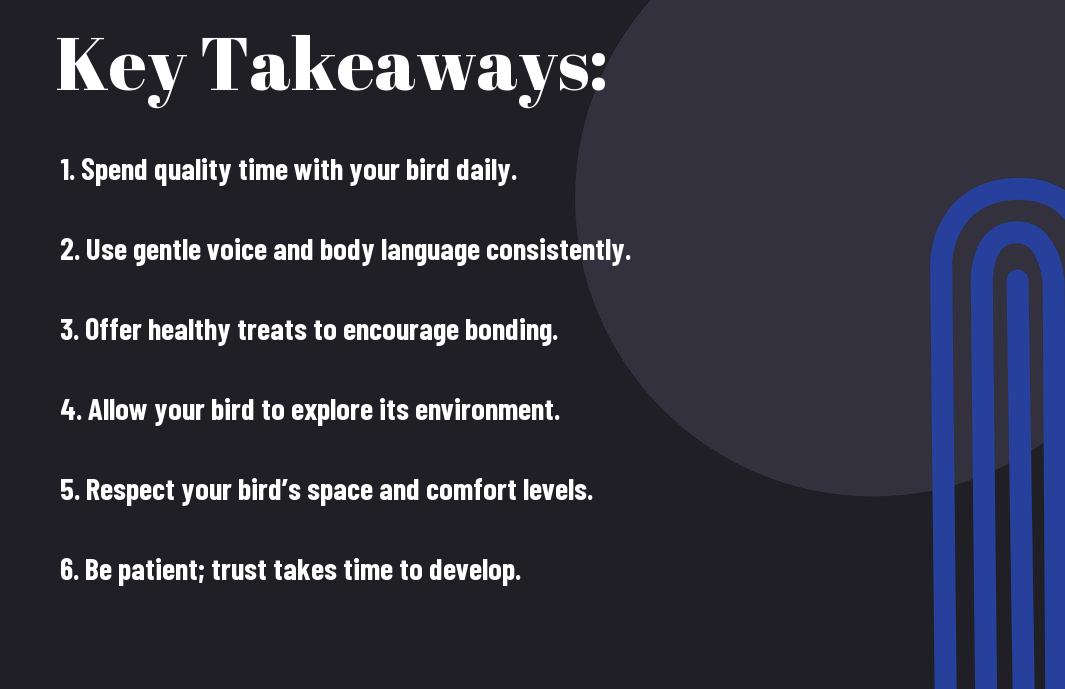
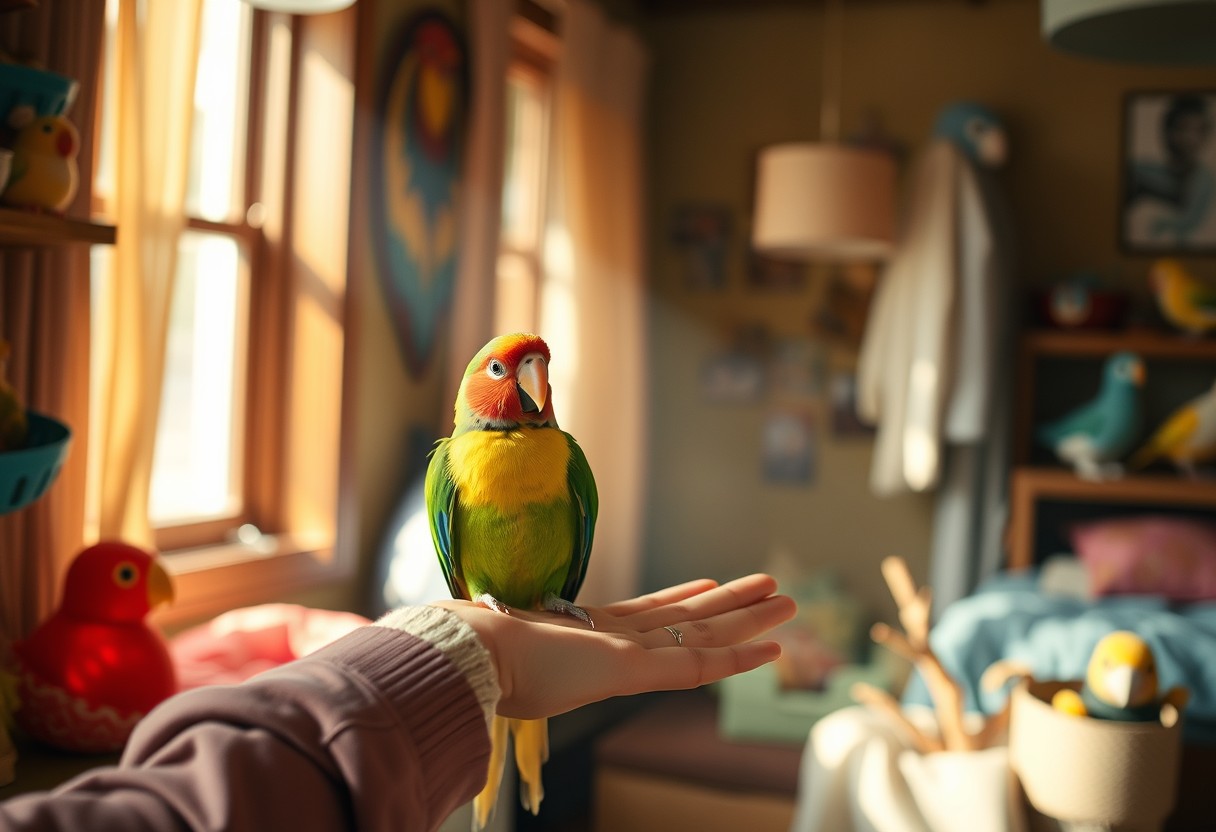
Understanding Your Pet Bird
Before you can effectively build a bond with your pet bird, it’s crucial to understand its unique nature and behaviors. Birds are social creatures with intricate communication styles, emotional needs, and specific dietary and environmental requirements. By familiarizing yourself with your bird’s characteristics, you can create a supportive environment that fosters trust and affection. The foundation of your relationship will depend heavily on your ability to recognize and respond to these needs.
The Importance of Bonding
Understanding the importance of bonding with your pet bird is crucial for fostering a harmonious relationship. Birds thrive on social interaction, and when they feel connected to you, they are more likely to exhibit positive behaviors, such as singing, playing, and mimicking. A strong bond also helps your bird feel secure, thereby reducing stress and potential behavioral issues that may arise from anxiety. Essentially, a well-bonded bird is typically a happy bird.
Additionally, a good bond allows for easier training and handling. When your bird trusts you, it will be more willing to engage in activities that enhance its well-being, such as exploring, foraging, and socializing. Not just a one-sided affair, as you invest time in building this relationship, you will notice a more fulfilling companionship that enhances both your lives.
Behavior Basics of Birds
On your journey to understanding your pet bird, it’s fundamental to grasp some behavior basics. Birds communicate through body language, vocalizations, and play, each of which provides insight into their emotional state. For example, a puffed-up bird may be feeling threatened or cold, while a bird that flatters its feathers is likely relaxed. Observing these signals can help you respond to your bird’s needs more effectively, enhancing your bond.
The social structure of birds demands interaction, and they often engage in conflict resolution through friendly behaviors. They perform rituals such as preening and feeding each other, which solidifies their social ties. This means that if you want to deepen your relationship, you should actively participate in bonding activities like hand-feeding, gentle stroking, or training tricks to emulate their natural social behaviors and affirm your place in their ‘flock’.
Building Trust
Any bird owner will tell you that trust is a cornerstone of a strong bond with your pet bird. Establishing this trust takes time and patience, but the rewards are well worth the effort. It is imperative to consider your bird’s perspective and set the stage for a positive relationship. By implementing specific strategies, you will create an environment where your bird feels safe, secure, and happy to interact with you.
Creating a Safe Environment
Safe environments are paramount in building trust with your bird. Birds are sensitive creatures, and a space that feels threatening can make them anxious and withdrawn. To create a haven for your feathered friend, ensure that their cage is in a quiet area of your home, free from loud noises and sudden movements. Additionally, ensure that there are no choking hazards or harmful substances within reach, as these can lead to distress and fear, ultimately impacting your bird’s willingness to engage.
Moreover, it’s crucial to maintain a predictable routine for feeding and interacting. Birds thrive on consistency, and knowing what to expect can significantly reduce their anxiety. Provide plenty of perches, toys, and safe spaces within the cage to allow your bird to explore and feel secure. A well-structured environment encourages your pet bird to relax and gradually trust you, laying the groundwork for deeper interactions.
Gradual Interactions
Creating a bond with your bird requires you to engage in interactions gradually. Start by allowing your bird to acclimate to your presence. Spend time sitting near their cage, talking softly or reading aloud. This helps your pet associate your voice with positive experiences. Once your bird seems comfortable, begin to stretch your hand toward them without forcing contact, allowing them to come to you at their own pace. Remember that forcing interactions can lead to increased fear and distrust, so patience is key.
Plus, the use of treats can be an effective tool in encouraging your bird to get closer to you. Offering small, healthy treats as a reward for approaching you builds a positive reinforcement cycle. Over time, consistently rewarding these behaviors will strengthen the connection between you and your feathered companion, helping them feel more secure and trusting of your interactions. Note, every small step counts in the journey toward a fulfilling and trusting relationship with your pet bird.
Showing Affection
Unlike some pets, birds are not always quick to show their affection or trust towards their human companions. As a bird owner, it is imperative to understand that building a bond with your feathered friend takes time, patience, and consistent effort. Showing affection is not merely about petting or cuddling; it’s about creating an environment where your bird feels safe, respected, and loved. Incorporating the right techniques and activities into your daily routine will facilitate the development of a strong emotional connection with your pet bird.
Positive Reinforcement Techniques
To enhance your bond with your bird, you should implement positive reinforcement techniques. This method focuses on rewarding your bird for exhibiting desirable behaviors, connecting good experiences with your presence. For example, offering your bird its favorite treat or praise when it approaches you can create a positive association, encouraging it to trust you over time. It is vital to remain calm and patient, as every bird has a unique timeline for developing trust.
To maximize the effectiveness of positive reinforcement, try using a clicker alongside treats. When your bird performs a desirable action, click the device and immediately offer the treat. This method reinforces to your bird that the behavior is what you want, creating a clear communication pathway. Over time, your bird will learn to associate your voice and presence with positive experiences, helping to deepen your bond.
Engaging in Play
An important aspect of showing affection to your pet bird involves engaging in playful activities that stimulate its mind and reinforce your connection. Birds are intelligent creatures that require mental stimulation and exercise, which means incorporating playtime into your routine is critical for their well-being. Interactive toys, such as swings, ladders, and puzzles, can provide entertainment while also encouraging your bird to bond with you as its playmate.
A variety of play options ensures that you can cater to your bird’s interests and energy levels. Consider hand-feeding toys, structured play sessions, or even simple games like hide and seek using toys or treats. Not only does play encourage a healthy lifestyle, but it also promotes trust and affection between you and your pet bird. Note, the more time you invest in play, the stronger your bond will become, fostering a loving and trusting relationship.
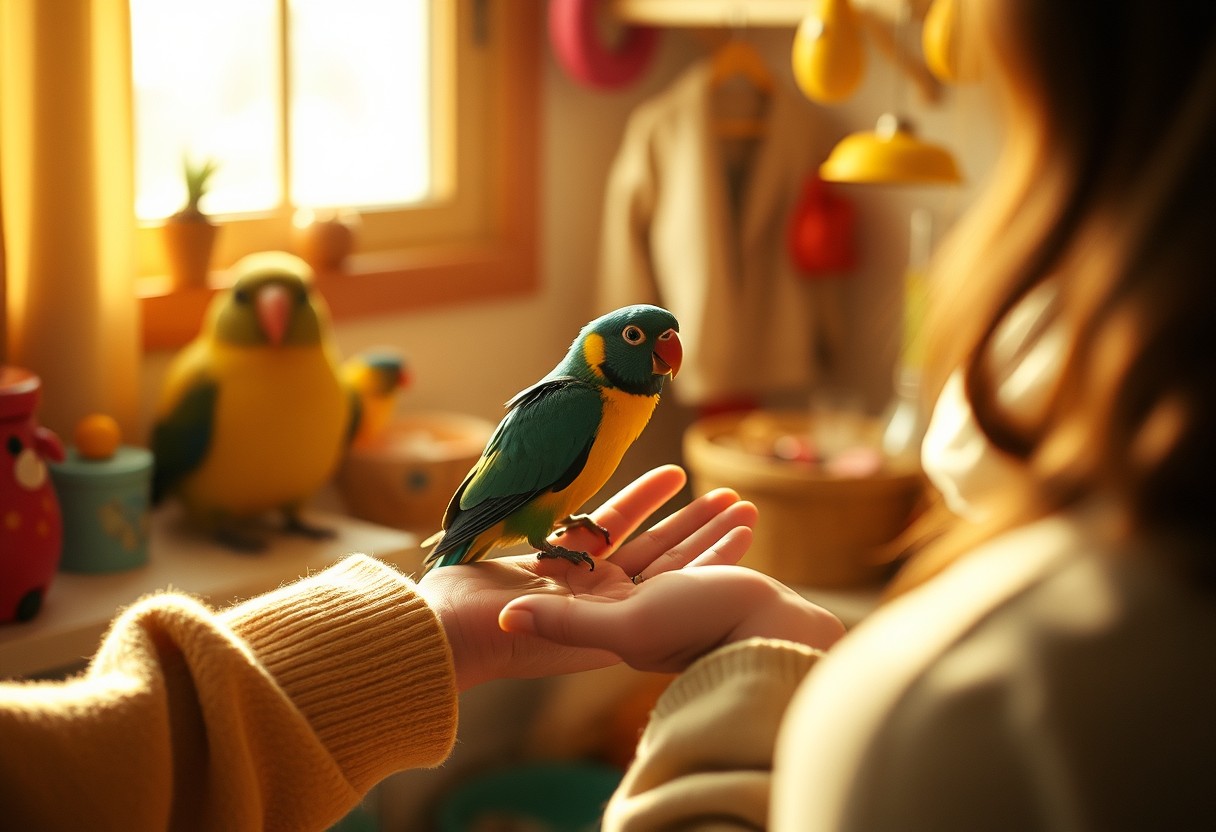
Maintenance of the Bond
Keep in mind that nurturing the bond you have with your pet bird is an ongoing process that requires commitment and attentiveness. A strong relationship isn’t built overnight; it flourishes with regular interaction and meaningful communication. By integrating simple daily routines into your interactions, you can help foster trust and affection. Consider spending quality time with your bird each day, whether it’s through talking, singing, or engaging in play. Birds are extremely social creatures and thrive on your attention and companionship.
Regular Communication and Interaction
With continuous interaction, you create an environment where your bird feels secure and valued. Make it a habit to talk to your bird in a calm and soothing voice, as this not only provides companionship but also strengthens the bond you share. Birds are sensitive to tone and will often mirror your emotions, so maintain an upbeat demeanor to promote a positive atmosphere. Engaging with your bird through interactive toys or training sessions can also stimulate their mind and solidify your connection.
Furthermore, consistency is key in maintaining the bond with your feathered friend. Schedule regular time each day dedicated solely to your bird, whether that involves training, playing, or simply relaxing together. Your bird will come to anticipate these moments, enhancing the trust you’ve built over time.
Recognizing Signs of Distress
Communication is a two-way street, and understanding your bird’s body language and vocalizations is just as crucial as providing companionship. When your bird is feeling distressed, you may notice changes in its behavior, such as excessive screeching, feather plucking, or aggressive posturing. Recognizing these signs early on is necessary for maintaining a strong bond. Addressing their discomfort promptly will reinforce that you are a reliable companion who understands their needs.
This is where keen observation becomes your greatest tool. Pay attention to your bird’s posture, vocal patterns, and eating habits. A bird that is suddenly quiet or withdrawn may be feeling anxious or unwell, while one exhibiting erratic behaviors may be overstimulated. Understanding these signs and responding with compassion will prove invaluable in maintaining your bird’s trust and affection. Recall, your ability to interpret and address your bird’s emotional state is critical in nurturing a healthy, long-lasting bond. By being attentive and responsive, you demonstrate that your relationship is built on mutual respect and understanding.
To Wrap Up
Considering all points, building a strong bond with your pet bird requires time, patience, and understanding. By taking the initiative to engage with your bird in a gentle and positive manner, you create an environment conducive to trust and affection. Regular interaction, whether through talking, training, or playful activities, not only reinforces the bond you share but also promotes your bird’s overall well-being. Keep in mind that each bird has its own personality, so tailor your approach based on their comfort level and individual preferences. This attention will foster a relationship where your bird feels safe and cherished.
Furthermore, nurturing trust takes consistent effort as you respond to your bird’s needs and behaviors. This not only builds affection but also encourages your bird to express themselves freely in your presence. As you invest in this relationship, you’ll likely discover the unique quirks and charming traits of your feathered friend, enhancing your time spent together. Ultimately, a well-cultivated bond between you and your pet bird leads to a fulfilling companionship that enriches both your lives, making the journey of pet ownership a rewarding experience.
FAQ
Q: How can I start building trust with my pet bird?
A: Building trust with your pet bird requires patience and consistency. Start by spending time near their cage, talking softly to them to get them accustomed to your voice. Use treats to encourage them to associate you with positive experiences. Allow them to come to you at their own pace, and avoid sudden movements that may scare them. Gradually introduce your hand inside the cage, but only when you’re confident the bird is comfortable. Over time, this will help reinforce a trusting relationship.
Q: What activities can I do with my pet bird to show affection?
A: There are numerous activities to show affection and bond with your pet bird. Daily interactions such as talking to them, singing, or reading aloud can enhance your connection. You can also provide opportunities for play, using toys that encourage interaction, like foraging toys or swings. Offering gentle head scratches or allowing them to perch on your shoulder can reinforce your bond. Additionally, consider training your bird with simple commands as this not only engages them mentally but also fosters trust and teamwork.
Q: How do I recognize if my pet bird is bonding with me?
A: Signs that your pet bird is bonding with you include seeking your company, engaging in playful behavior around you, and showing interest in your activities. Look for body language cues such as relaxed posture, preening themselves in your presence, or attempting to touch you with their beak. Vocalizations that are softer and more varied can also indicate comfort and affection. When your bird willingly comes to you or displays curiosity towards you, these are strong indicators that a bond is forming.
